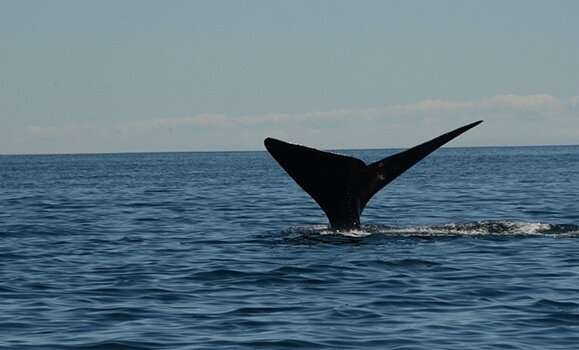Listening to North Atlantic right whales has helped researchers determine migratory corridors and patterns that could inform conservation efforts. Credit: Dalhousie University
North Atlantic right whales have cruised the waters off Canada and the eastern seaboard for millennia as they pursue their preferred food source—crustaceans the size of a grain of rice.
About a third of the world's remaining 340 whales are known to venture into the Bay of Fundy, the Scotian Shelf and more recently into the Gulf of St. Lawrence after making the long trek from Florida and Georgia, where they have their calves.
Yet researchers trying to save the critically endangered species continue to grapple with an enduring and frustrating question over where the majority of these animals are.
New research out of Dalhousie University is filling in some of those gaps with help from the whales themselves: scientists listened for the whales' distinct upcalls as they tracked through Canadian waters.
Detecting migratory corridors
Delphine Durette-Morin, who was a MSc student at Dal while undertaking the research and is now an assistant scientist at the Canadian Whale Institute, deployed an array of moorings and gliders throughout the Atlantic continental shelf from 2015 to 2017 to see if she and her colleagues could capture right whale vocalizations. If so, their data would tell scientists where the animals are and when, and help focus measures to protect them from ship strikes and gear entanglements.
"We were hoping to define right whale distribution in the northern portion of their range in Canadian waters since it is not well defined due to lack of monitoring in the northern waters," she says.
"This is especially important for the years since 2015, as there had been a distribution shift into the unprotected waters of the Gulf of St. Lawrence. We were also hoping to identify the migratory corridors the whales use to enter the gulf and any unidentified high-use habitats."
The sound recordings indicated that the whales were not in the Labrador Sea or Newfoundland Shelf, even though their preferred prey was in those areas. They were detected on the Scotian Shelf nearly year-round.
What surprised the researchers is that right whales were in the Cabot Strait from May through December, suggesting that they may be coming and going in and out of the gulf throughout the season rather than just at the beginning and end.
Another tool for protection
The information is vital because North Atlantic right whales are on the brink of extinction with only several hundred left, the majority of which are not breeding females. Their numbers have been dropping steadily over the last several decades due largely to ship strikes and entanglements in fishing gear. They are also producing fewer calves than they had previously.
Wildlife experts and conservationists have worked to alter shipping lanes in a bid to reroute large vessels around known right whale habitats and more recently, managers in the shipping industry have implemented dynamic speed restrictions in shipping lanes.
Fisheries managers have also closed areas to fishing activities that are known to endanger the slow-moving animals. Durette-Morin says this new information can serve as both a baseline to measure against future changes and a tool for agencies that manage such things as vessel speeds and fishing activities.
"This is the only existing data of a big picture right whale distribution in Canadian waters, specifically for 2015 to 2017. This period of time is important because right whale distribution was especially uncertain following a shift," says Durette-Morin.
The researchers used a network of hydrophones or underwater microphones provided by four Canadian organizations. Passive acoustic monitoring data were collected and analyzed from 67 moorings and 13 gliders deployed throughout the Atlantic Canadian continental shelf. The recordings were analyzed for the presence of characteristic right whale upcalls.
The work is published in the journal Frontiers in Marine Science.
More information: Delphine Durette-Morin et al, The distribution of North Atlantic right whales in Canadian waters from 2015-2017 revealed by passive acoustic monitoring, Frontiers in Marine Science (2022). DOI: 10.3389/fmars.2022.976044
Journal information: Frontiers in Marine Science
Provided by Dalhousie University
























